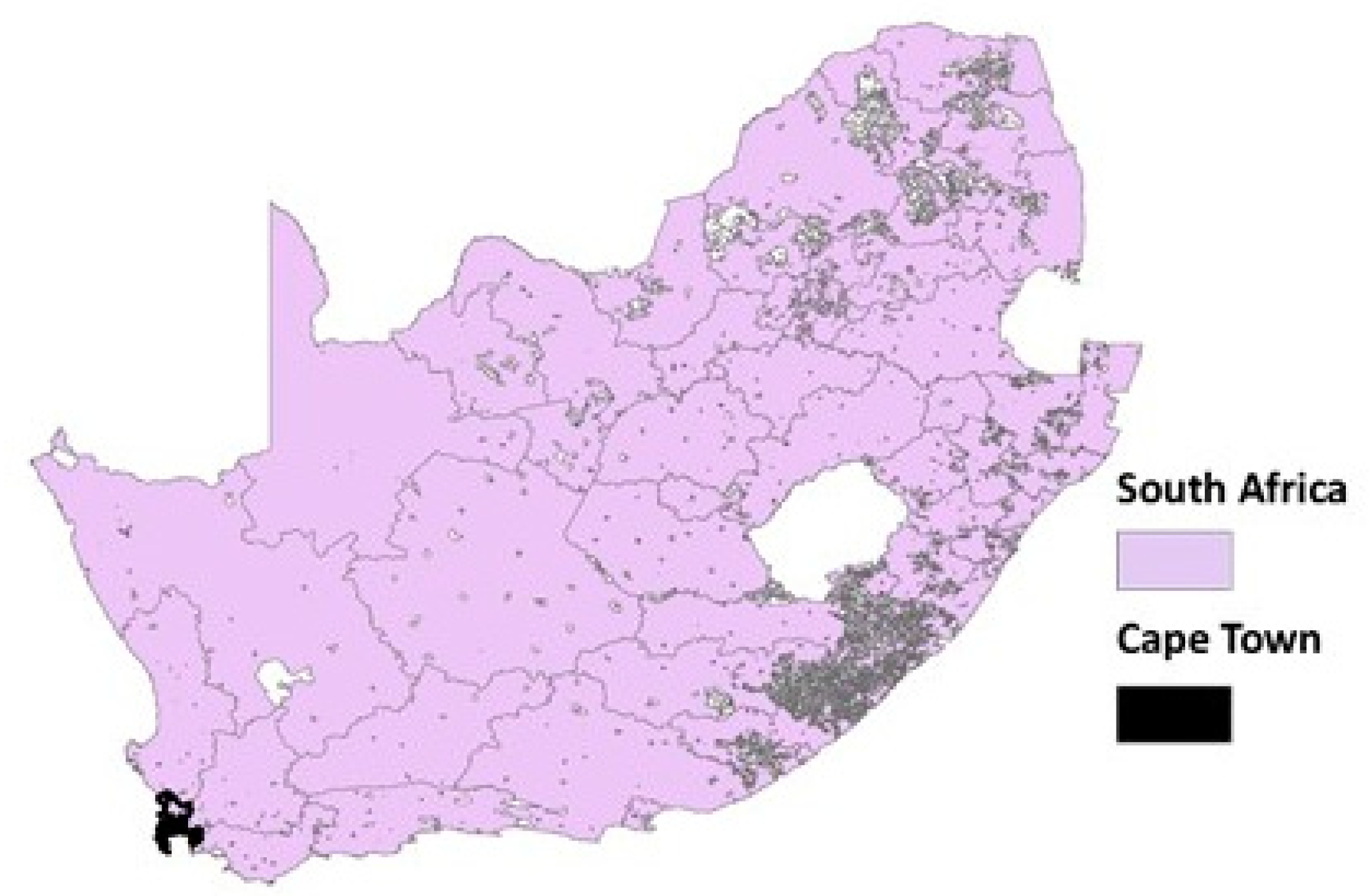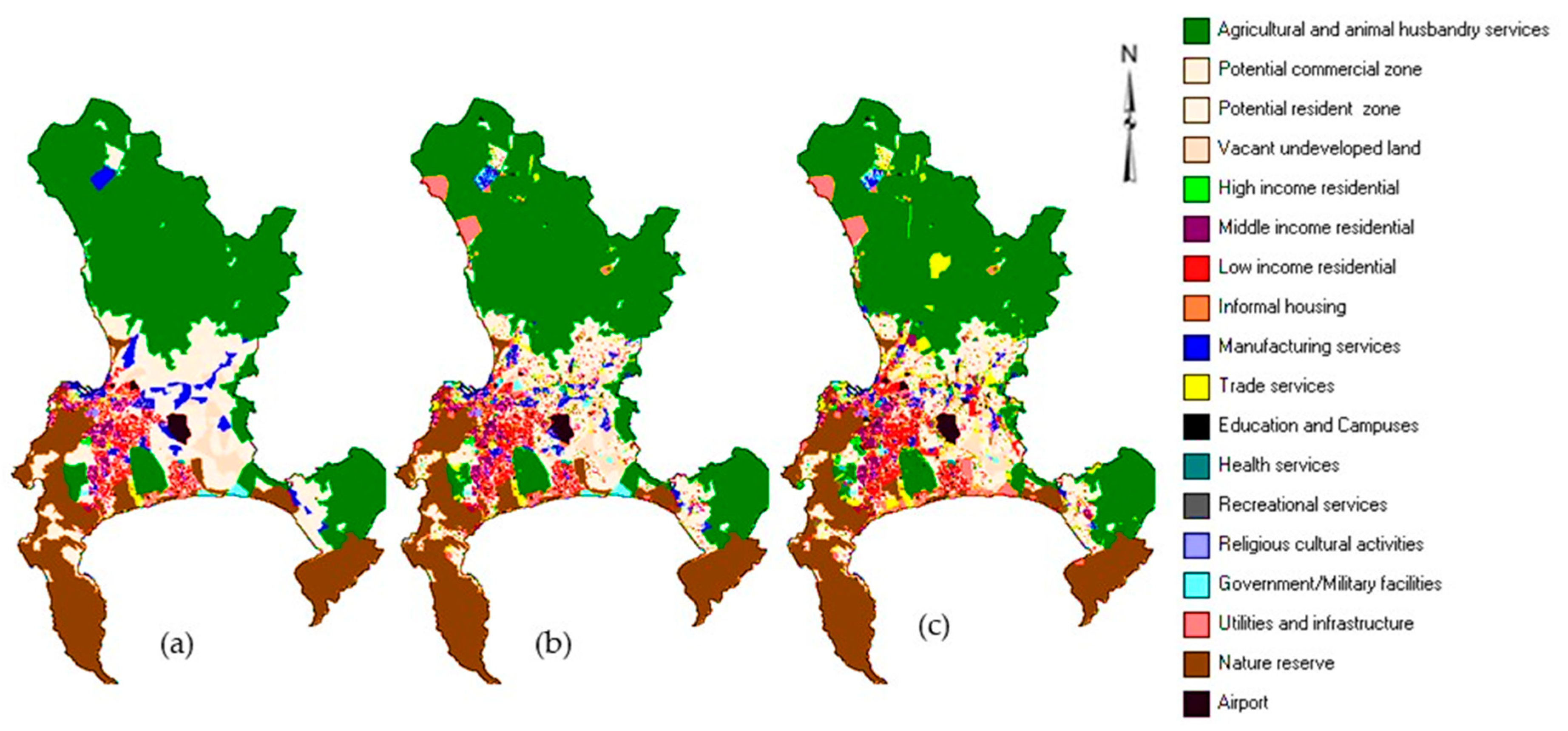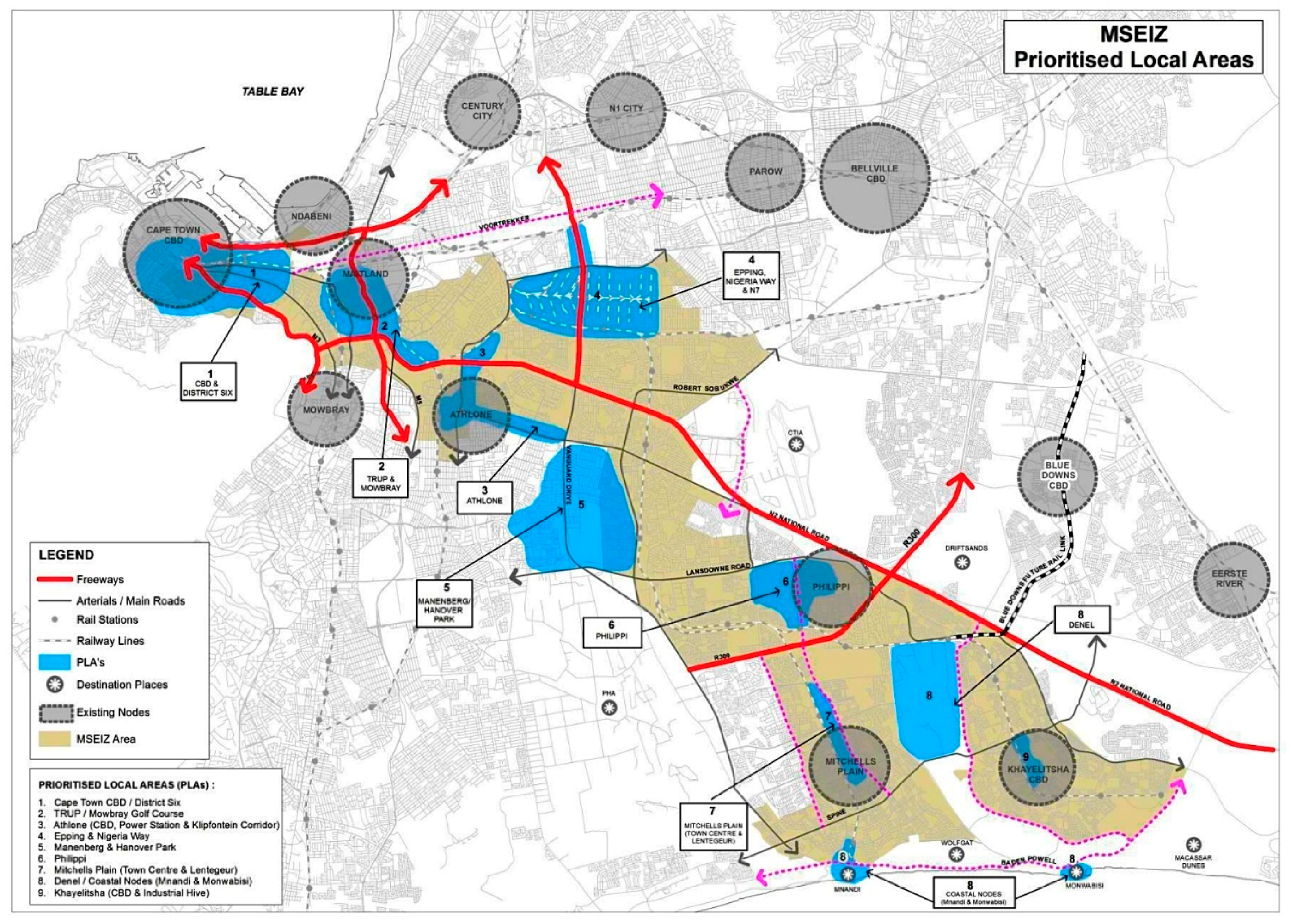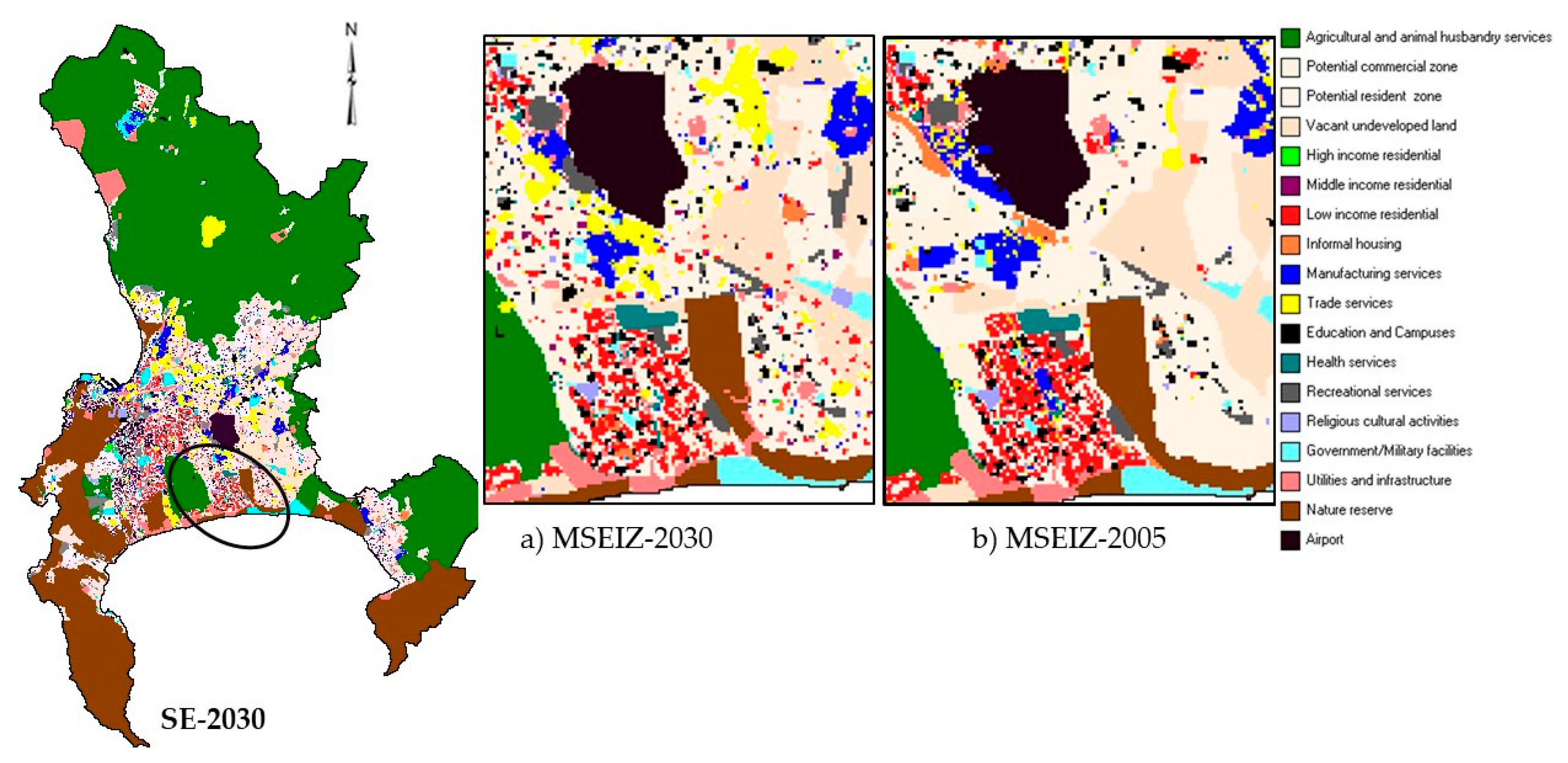Lessons Learned from Applying an Integrated Land Use Transport Planning Model to Address Issues of Social and Economic Exclusion of Marginalised Groups: The Case of Cape Town, South Africa
Abstract
:1. Introduction
Informal Settlement and the Urban Densities Debate in South Africa
2. Materials and Methods
2.1. Study Area
2.2. The METRONAMICA Land Use Transport Model (M-LUT)
- = potential for land use class f in cell c,
- = total accessibility for land use f in cell c,
- = physical suitability for land use class f in cell c,
- = zoning status which are laws and regulations pertaining to land use class f in cell c,
- = neighbourhood effect for land use f in cell c and
- = random perturbation term which controls the scatter and density of land uses on the landscape.
2.2.1. Application of the M-LUT in Cape Town
2.2.2. Land Use Model Data
2.2.3. Transport Model Data
2.3. Calibration and Validation of the Model for Cape Town
2.3.1. Method Used to Assess the Performance of the Cape Town Land Use Transport Model
2.4. Results from the Calibration and Validation of the Model
2.4.1. Land Use Model Results
2.4.2. Transport Model Results
2.4.3. Calibration of the Link between the Land Use and Transport Model
2.4.4. Results from the Calibration and Validation of the Integrated Model
3. Application of the Model to Explore Different Land Use Development Strategies
3.1. Scenario 1: Business as Usual (BAU)
3.2. Scenario 2: Proliferation of Informal Settlements (PI) Scenario
3.3. Scenario 3: Redressing of Social Exclusion (SE) Scenario
3.4. Results from the Urban Development Scenarios
- determine the spatial development of the city under different scenarios until 2030.
- evaluate the change in zonal accessibility for manufacturing and trade and services in relation to informal and low-income residential areas.
- determine the distance to locations with manufacturing and trade and services from the informal and low-income housing.
- determine the average commuting distance to economic centres from informal and low-income housing under different scenarios.
3.4.1. Spatial Expansion under All Scenarios
3.4.2. Change in Zonal Accessibility to Economic Centres for Low-Income and Informal Settlement Dwellers
3.4.3. Difference in Commuting Distance
4. Discussion
5. Conclusions
Author Contributions
Funding
Institutional Review Board Statement
Informed Consent Statement
Data Availability Statement
Acknowledgments
Conflicts of Interest
Appendix A
- = explicit accessibility at cell c for land use f if cell c is occupied by an impassable land use,
- = zonal accessibility of land use f in the zone zc where cell c is located,
- = local accessibility at cell c of land use f to link type s,f(c) = denotes the land use in cell c, and
- = implicit accessibility at cell c for land use f.
- = set of impassable land uses
Appendix A.1. Local Accessibility
- local accessibility of cell c for land use f to link type s,
- = distance between cell c and the nearest link covered by link type s, and
- = distance decay (a calibrated parameter) and represents the change in local accessibility given a land use type f and link type s over a unit of distance.
Appendix A.2. Implicit Accessibility
- implicit accessibility of cell c for land use f,
- = implicit accessibility for land use f of a cell that has an urban land use,
- = implicit accessibility for land use f of a cell with a non-urban land use,
- f(c) = denotes the land use in cell c,
- = represent the set of urbanised land uses
Appendix A.3. Explicit Accessibility
- = explicit accessibility for land use f at cell,
- f(c) = denotes the land use in cell c,
- = implicit accessibility of cell c for land use f if it is impassable
- = the zonal accessibility for activity a in zone j,
- = is the percentage share of activity a in zone .
- = sensitivity to cost for activity a, and
- = is the average transport costs between zone i and j
- = the weighted zonal accessibility for activity a in zone j,
- = is the function land use f for transport activity a and represents the minimum zonal accessibility.
References
- UN. The Sustainable Development Goals Report; United Nations: New York, NY, USA, 2018. [Google Scholar]
- UN. World Urbanisation Prospects: The 2014 Revision; United Nations: New York, NY, USA, 2015. [Google Scholar]
- Jones, P. Formalizing the informal: Understanding the position of informal settlements and slums in sustainable urbanization policies and strategies in Bandung, Indonesia. Sustainability 2017, 9, 1436. [Google Scholar] [CrossRef] [Green Version]
- Dowall, D.E. Comparing Karachi’s informal and formal housing delivery systems. Cities 1991, 8, 217–227. [Google Scholar] [CrossRef]
- Baross, P. Sequencing land development: The price implications of legal and illegal settlement growth. Transform. Land Supply Syst. Third World Cities 1990, 57, 64–65. [Google Scholar]
- Malavolti, C. Towards Resilience: Informality and affordable housing in the inner city of Johannesburg. In Urban Solutions: Metropolitan Approaches, Innovation in Urban Water and Sanitation, and Inclusive Smart Cities; Wilson Centre: Washington, DC, USA, 2016; pp. 72–89. ISBN 9781938027529. [Google Scholar]
- Ward, P. Self-help Housing: A Critique. In The Wiley-Blackwell Encyclopedia of Urban and Regional Studies; Alexandrine Press, Mansell Publishing Ltd.: London, UK, 1982; pp. 1–6. [Google Scholar]
- Naik, M. Informal Rental Housing Typologies and Experiences of Low-income Migrant Renters in Gurgaon, India. Environ. Urban. Asia 2015, 6, 154–175. [Google Scholar] [CrossRef]
- Hermanson, J.A. Slums, Informal Settlements and Inclusive Growth in Cities: Examples from Morocco and Colombia; IHC Global Coalition for Inclusive Housing and Sustainable Cities: Washington, DC, USA, 2016. [Google Scholar]
- Roy, A. Why India cannot plan its cities: Informality, insurgence and the idiom of urbanization. Plan. Theory 2009, 8, 76–87. [Google Scholar] [CrossRef]
- Roy, A. Urban Informality. J. Am. Plan. Assoc. 2005, 71, 147–158. [Google Scholar] [CrossRef]
- Turok, I. Informal Settlements: Poverty Traps or Ladders to Work? 2015. Available online: https://www.researchgate.net/publication/283583113_Informal_settlements_poverty_traps_or_ladders_to_work (accessed on 6 January 2021).
- Misselhorn, M. Position Paper on Informal Settlements Upgrading: Part of a Strategy for the Second Economy for the Office of the South African Presidency; Urban Landmark: Cape Town, South Africa, 2008. [Google Scholar]
- DoH. “Breaking New Ground” a Comprehensive Plan for the Development of Sustainable Human Settlements; Department of Housing: Pretoria, South Africa, 2004.
- Fitchett, A. Adaptive Co-management in the Context of Informal Settlements. Urban. Forum 2014, 25, 355–374. [Google Scholar] [CrossRef]
- Bradlow, B.; Bolnick, J.; Shearing, C. Housing, institutions, money: The failures and promise of human settlements policy and practice in South Africa. Environ. Urban. 2011, 23, 267–275. [Google Scholar] [CrossRef]
- Brown-Luthango, M.; Reyes, E.; Gubevu, M. Informal settlement upgrading and safety: Experiences from Cape Town, South Africa. J. Hous. Built Environ. 2017, 32, 471–493. [Google Scholar] [CrossRef]
- HDA. Participatory Action Planning for Informal Settlement Upgrading; Housing Development Agency: Johannesburg, South Africa, 2015. [Google Scholar]
- Massey, R. Integral Theory: A Tool for Mapping and Understanding Conflicting Governmentalities in the Upgrading of Cape Town’s Informal Settlements. Urban. Forum 2015, 26, 303–319. [Google Scholar] [CrossRef]
- Del Mistro, R.; Hensher, D.A. Upgrading Informal Settlements in South Africa: Policy, Rhetoric and what Residents really Value. Hous. Stud. 2009, 24, 333–354. [Google Scholar] [CrossRef]
- Massey, R.T. The Effect of Informal Settlement Upgrading on Women’s Social Networks: Layout Versus Location. Urban. Forum 2017, 28, 205–217. [Google Scholar] [CrossRef]
- RSA. White Paper on Reconstruction and Development; Government of South Africa: Johannesburg, South Africa, 1994; Volume 353, pp. 1–82.
- DoH. Urban Development Framework; Department of Housing: Pretoria, South Africa, 1997.
- RSA. Integrated Urban. Developments Framework; Government of South Africa: Pretoria, South Africa, 2016.
- Gerber, J. R10bn Budget Slash for Human Settlements Department. Available online: https://www.news24.com/news24/SouthAfrica/News/r10bn-budget-slash-for-human-settlements-department-20180510 (accessed on 6 January 2021).
- Turok, I. Persistant polarisation post apartheid? Progress towards urban integration in Cape Town. Urban. Stud. 2002, 38, 2349–2377. [Google Scholar] [CrossRef]
- Palmer, I.; Brown-Luthango, M.; Berrisford, S. The Economic and Fiscal Costs of Inefficient Land Use Patterns in South Africa; Finance and Fiscal Commission, World Bank Group: Washingtion, DC, USA, 2011. [Google Scholar]
- DoT. White Paper on National Transport Policy; Governmnet of South Africa: Pretoria, South Africa, 1996.
- DoT. The National Land Transport Strategic Framework (NLTSF); Government of South Africa: Pretoria, South Africa, 2009.
- Tamuka Moyo, H.; Zuidgeest, M.H. Analyzing the temporal location of employment centers relative to residential areas in Cape Town: A spatial metrics approach. J. Transp. Land Use 2018, 11, 519–540. [Google Scholar] [CrossRef]
- RIKS. Metronamica Documentation; Research Institute of Knowledge Systems: Maastricht, The Netherlands, 2011. [Google Scholar]
- DoH. Strategic Plan 2015–2020; Government of South Africa: Pretoria, South Africa, 2015.
- CoCT. Integrated Human Settlements Five-Year Strategic Plan. July 2012–June 2017; CoCT City of Cape Town: Cape Town, South Africa, 2013.
- Turok, I.; Watson, V. Divergent development in South African cities: Strategic challenges facing Cape Town. Urban. Forum 2001, 12, 119–138. [Google Scholar] [CrossRef]
- Acheampong, R.A.; Silva, E. Land use–transport interaction modeling: A review of the literature and future research directions. J. Transp. Land Use 2015, 11–38. [Google Scholar] [CrossRef]
- Aljoufie, M.; Zuidgeest, M.; Brussel, M.; van Vliet, J.; van Maarseveen, M. A cellular automata-based land use and transport interaction model applied to Jeddah, Saudi Arabia. Landsc. Urban. Plan. 2013, 112, 89–99. [Google Scholar] [CrossRef]
- Wegener, M.; Fuerst, F. Land-Use Transport Interaction: State of the Art. SSRN Electron. J. 2011. [Google Scholar] [CrossRef]
- Waddell, P. Integrated land use and transportation planning and modelling: Addressing challenges in research and practice. Transp. Rev. 2011, 31, 209–229. [Google Scholar] [CrossRef]
- Echenique, M.H.; Flowerdew, A.D.J.; Hunt, J.D.; Mayo, T.R.; Skidmore, I.J.; Simmonds, D.C. The Meplan models of bilbao, Leeds and Dortmund: Foreign summaries. Transp. Rev. 1990, 10, 309–322. [Google Scholar] [CrossRef]
- Zhong, M.; Hunt, J.D.; Abraham, J.E. Design and Development of a Statewide Land Use Transport Model for Alberta. J. Transp. Syst. Eng. Inf. Technol. 2007, 7, 79–89. [Google Scholar] [CrossRef]
- Clay, M.J. Developing an integrated land-use/transportation model for small to medium-sized cities: Case study of Montgomery, Alabama. Transp. Plan. Technol. 2010, 33, 679–693. [Google Scholar] [CrossRef] [Green Version]
- Harvey, E.P.; Cardwell, R.C.; McDonald, G.W.; van Delden, H.; Vanhout, R.; Smith, N.J.; Joon-hwan, K.; Forgie, V.E.; van den Belt, M. Developing integrated models by coupling together existing models; land use, economics, demographics and transport in Wellington, New Zealand. Comput. Environ. Urban. Syst. 2019, 74, 100–113. [Google Scholar] [CrossRef]
- Shahumyan, H.; Convery, S.; Casey, E. Exploring land use-transport interactions in the Greater Dublin Region using the MOLAND model. In Proceedings of the 1st Annual Conference of the Irish Transport Research Network, Dublin, Ireland, 30 August–1 September 2010. [Google Scholar]
- Barredo, J.I.; Demicheli, L.; Lavalle, C.; Kasanko, M.; McCormick, N. Modelling future urban scenarios in developing countries: An application case study in Lagos, Nigeria. Environ. Plan. B Plan. Des. 2004, 31, 65–84. [Google Scholar] [CrossRef] [Green Version]
- Guzman, L.A.; Escobar, F.; Peña, J.; Cardona, R. A cellular automata-based land-use model as an integrated spatial decision support system for urban planning in developing cities: The case of the Bogotá region. Land Use Policy 2020, 92, 104445. [Google Scholar] [CrossRef]
- Aljoufie, M.; Brussel, M.; Zuidgeest, M.; van Delden, H.; van Maarseveen, M. Integrated analysis of land-use and transport policy interventions. Transp. Plan. Technol. 2016, 39, 329–357. [Google Scholar] [CrossRef]
- Ustaoglu, E.; Williams, B.; Petrov, L.O.; Shahumyan, H.; van Delden, H. Developing and assessing alternative land-use scenarios from the MOLAND Model: A scenario-based impact analysis approach for the evaluation of rapid rail provisions and urban development in the Greater Dublin Region. Sustainability 2017, 10, 61. [Google Scholar] [CrossRef] [Green Version]
- White, R.; Engelen, G. A Calibration Procedure for Constrained Large Neighbourhood Cellular Automata based Land Use Models. In Proceedings of the 13th European Colloquium on Theoretical and Quantitative Geography, Lucca, Italy, 5–9 September 2003; pp. 11–17. [Google Scholar]
- van Delden, H.; Hurkens, J. A generic Integrated Spatial Decision Support System for urban and regional planning. In Proceedings of the 19th International Congress on Modelling and Simulation, Perth, Australia, 12–16 December 2011. [Google Scholar]
- White, R.; Engelen, G. Cellular automata and fractal urban form: A cellular modelling approach to the evolution of urban land-use patterns. Environ. Plan. A 1993, 25, 1175–1199. [Google Scholar] [CrossRef] [Green Version]
- White, R.; Engelen, G.; Uljee, I. The use of constrained cellular automata for high-resolution modelling of urban land-use dynamics. Environ. Plan. B Plan. Des. 1997, 24, 323–343. [Google Scholar] [CrossRef]
- De Dios Ortuzar, J.; Willumsen, L.G. Modelling Transport, 4th ed.; John Wiley & Sons Ltd.: Chichester, UK, 2011; ISBN 9780470760390. [Google Scholar]
- Aljoufie, M.; Zuidgeest, M.; Brussel, M.; van Maarseveen, M. Urban growth and transport: Understanding the spatial temporal relationship. WIT Trans. Built Environ. 2011, 116, 315–328. [Google Scholar] [CrossRef] [Green Version]
- Hitge, G.; Van der Schuren, M. Comparison of travel time between private car and public transport in Cape Town. J. S. Afr. Inst. Civ. Eng. 2015, 57, 35–43. [Google Scholar] [CrossRef]
- STATSSA. NHTS Provincial Report Western Cape Profile; Statistics South Africa: Pretoria, South Africa, 2014; ISBN 9780621431414.
- Turok, I.; Borel-Saladin, J. Is urbanisation in South Africa on a sustainable trajectory? Dev. S. Afr. 2014, 31, 675–691. [Google Scholar] [CrossRef]
- STATSSA. October Household Survey; Statistics South Africa: Pretoria, South Africa, 1996.
- STATSSA. October Household Survey; Statistics South Africa: Pretoria, South Africa, 1997.
- STATSSA. South Africa Population Census; Statistics South Africa: Pretoria, South Africa, 1996.
- STATSSA. October Household Survey; Statistics South Africa: Pretoria, South Africa, 1995.
- DoT. Key Results of the National Household Travel Survey: The First South. African National Household Travel Survey 2003; Statistics South Africa: Pretoria, South Africa, 2003.
- Abraham, J.E.; Hunt, J.D. Parameter Estimation Strategies for Large Scale Urban Models. Transp. Res. Board Annu. Meet. 2000, 1722, 9–16. [Google Scholar] [CrossRef]
- van Vliet, J.; Hagen-Zanker, A.; Hurkens, J.; van Delden, H. A fuzzy set approach to assess the predictive accuracy of land use simulations. Ecol. Model. 2013, 261–262, 32–42. [Google Scholar] [CrossRef]
- Brown, D.G.; Page, S.; Riolo, R.; Zellner, M.; Rand, W. Path dependence and the validation of agent-based spatial models of land use. Int. J. Geogr. Inf. Sci. 2005, 19, 153–174. [Google Scholar] [CrossRef] [Green Version]
- van Vliet, J.; Bregt, A.K.; Hagen-Zanker, A. Revisiting Kappa to account for change in the accuracy assessment of land-use change models. Ecol. Model. 2011, 222, 1367–1375. [Google Scholar] [CrossRef]
- Newland, C.P.; Zecchin, A.C.; Maier, H.R.; Newman, P.; Delden, H. Van Empirically derived method and software for semi-automatic calibration of Cellular Automata land-use models. Environ. Model. Softw. 2018, 108, 208–239. [Google Scholar] [CrossRef]
- van Vliet, J. Calibration and Validation of Land-Use Models; Wageningen University: Wageningen, The Netherlands, 2013. [Google Scholar]
- Clarke, K.C.; Couclelis, H.; Clarke, K.C. The role of spatial metrics in the analysis and modeling of urban land use change. Comput. Environ. Urban. Syst. 2005, 29, 369–399. [Google Scholar] [CrossRef]
- Hewitt, R.; Díaz-Pacheco, J. Stable models for metastable systems? Lessons from sensitivity analysis of a Cellular Automata urban land use model. Comput. Environ. Urban. Syst. 2017, 62, 113–124. [Google Scholar] [CrossRef]
- Wickramasuriya, R.C.; Bregt, A.K.; van Delden, H.; Hagen-Zanker, A. The dynamics of shifting cultivation captured in an extended Constrained Cellular Automata land use model. Ecol. Model. 2009, 220, 2302–2309. [Google Scholar] [CrossRef]
- Hagen-Zanker, A.; Lajoie, G. Neutral models of landscape change as benchmarks in the assessment of model performance. Landsc. Urban. Plan. 2008, 86, 284–296. [Google Scholar] [CrossRef] [Green Version]
- TDA. 2013–2018 Comprehensive Integrated Transport Plan; TDA City of Cape Town: Cape Town, South Africa, 2012.
- TDA. Comprehensive Integrated Transport Plan 2017–2022; TDA City of Cape Town: Cape Town, South Africa, 2017.
- Pontius, R.; Huffaker, D.; Denman, K. Useful techniques of validation for spatially explicit land-change models. Ecol. Model. 2004, 179, 445–461. [Google Scholar] [CrossRef]
- CoCT. Integrated Development Plan 2017–2022; CoCT City of Cape Town: Cape Town, South Africa, 2017.
- Haase, D.; Schwarz, N. Simulation models on human-nature interactions in urban landscapes: A review including spatial economics, system dynamics, cellular automata and agent-based approaches. Living Rev. Landsc. Res. 2009, 3. [Google Scholar] [CrossRef]
- TDA. Built Environment Performance Plan. 2018/19; TDA City of Cape Town: Cape Town, South Africa, 2018.
- Herron, B. City Committed to Creating an Inclusive Cape Town. Available online: http://www.housinginsouthernafrica.co.za/opinionistas/225-city-committed-to-creating-an-inclusive-cape-town (accessed on 25 September 2018).
- McGaffin, R. Housing in Cape Town in 2018: A Draft Discussion Document; Urban Real Estate Research Unit: University of Cape Town, Cape Town, South Africa, 2018. [Google Scholar]
- Turok, I.; Borel-Saladin, J. Backyard shacks, informality and the urban housing crisis in South Africa: Stopgap or prototype solution? Hous. Stud. 2016, 31, 384–409. [Google Scholar] [CrossRef]









| Vacant | Functions | Features |
|---|---|---|
|
|
|
| Fuzzy Kappa | Cape Town Model (Data 2005 vs. Simulated 2005) | Benchmark Random Constraint Match |
|---|---|---|
| High-income residential | 0.801 | 0.771 |
| Middle-income residential | 0.907 | 0.874 |
| Low-income residential | 0.885 | 0.858 |
| Informal housing | 0.058 | 0.023 |
| Manufacturing services | 0.873 | 0.806 |
| Trade services | 0.589 | 0.379 |
| Kappa Simulation | Cape Town Model Calibration (Real 2005 vs. Simulated 2005) | Cape Town Model Validation (Real 2010 vs. Simulated 2010) |
|---|---|---|
| High income residential | 0.104 | 0.136 |
| Middle income residential | 0.212 | 0.163 |
| Low income residential | 0.252 | 0.143 |
| Informal housing | 0.005 | 0.002 |
| Manufacturing services | 0.524 | 0.119 |
| Trade services | 0.234 | 0.284 |
| Land use Maps | Fractal Dimensions |
|---|---|
| Real map 1995 | 1.033 |
| Real map 2005 | 1.032 |
| Simulated map 2005 | 1.027 |
| Real map 2010 | 1.031 |
| Simulated map 2010 | 1.027 |
| RCM (Benchmark) | 1.266 |
| Integrated Model Calibration Period | Integrated Model Validation Period | Random Constraint Match (Benchmark) | |
|---|---|---|---|
| 2005 | 2010 | 2010 | |
| Kappa | 0.934 | 0.849 | 0.797 |
| Kappa Simulation | 0.688 | 0.293 | N/A |
| Fuzzy Kappa | 0.950 | 0.881 | 0.840 |
| Fuzzy Kappa Simulation | 0.704 | 0.325 | N/A |
| Fractal dimension | 1.023 | 1.027 | 1.266 |
| Scenarios | Population | Spatial Development | |
|---|---|---|---|
| Suggested policy interventions | Business as usual (BAU) |
|
|
| Proliferation of informal settlements (PI) |
|
| |
| Redressing social exclusion (SE) |
|
|
| Urban Development Scenario | Land Use | Distance to Centres of Economic Activities (km) |
|---|---|---|
| Business-as-usual (BAU) | Low-income residential Informal settlements | 13.4 12.0 |
| Proliferation of Informal Settlements (PI) | Low-income residential Informal settlements | 6.9 10.0 |
| Social Exclusion (SE) | Low-income residential Informal settlements | 7.0 7.6 |
Publisher’s Note: MDPI stays neutral with regard to jurisdictional claims in published maps and institutional affiliations. |
© 2021 by the authors. Licensee MDPI, Basel, Switzerland. This article is an open access article distributed under the terms and conditions of the Creative Commons Attribution (CC BY) license (http://creativecommons.org/licenses/by/4.0/).
Share and Cite
Tamuka Moyo, H.T.; Zuidgeest, M.; van Delden, H. Lessons Learned from Applying an Integrated Land Use Transport Planning Model to Address Issues of Social and Economic Exclusion of Marginalised Groups: The Case of Cape Town, South Africa. Urban Sci. 2021, 5, 10. https://doi.org/10.3390/urbansci5010010
Tamuka Moyo HT, Zuidgeest M, van Delden H. Lessons Learned from Applying an Integrated Land Use Transport Planning Model to Address Issues of Social and Economic Exclusion of Marginalised Groups: The Case of Cape Town, South Africa. Urban Science. 2021; 5(1):10. https://doi.org/10.3390/urbansci5010010
Chicago/Turabian StyleTamuka Moyo, Hazvinei Tsitsi, Mark Zuidgeest, and Hedwig van Delden. 2021. "Lessons Learned from Applying an Integrated Land Use Transport Planning Model to Address Issues of Social and Economic Exclusion of Marginalised Groups: The Case of Cape Town, South Africa" Urban Science 5, no. 1: 10. https://doi.org/10.3390/urbansci5010010
APA StyleTamuka Moyo, H. T., Zuidgeest, M., & van Delden, H. (2021). Lessons Learned from Applying an Integrated Land Use Transport Planning Model to Address Issues of Social and Economic Exclusion of Marginalised Groups: The Case of Cape Town, South Africa. Urban Science, 5(1), 10. https://doi.org/10.3390/urbansci5010010




